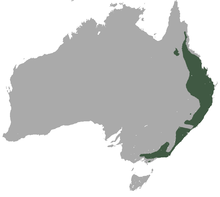Giant glide bag
| Giant glide bag | ||||||||||||
|---|---|---|---|---|---|---|---|---|---|---|---|---|

Southern large flying booty ( Petauroides volans ) |
||||||||||||
| Systematics | ||||||||||||
|
||||||||||||
| Scientific name | ||||||||||||
| Petauroides | ||||||||||||
| Thomas , 1888 |
The giant gliding bag ( Petauroides ), also called large flying bag , are a genus of mammals living in Australia . Despite their Gleitmembranen they do not belong to the family of gliders , but are in the ring marsupials classified (Pseudocheiridae). Originally the genus was monotypical with Petauroides volans as the only species. In the marsupial volume of the " Handbook of the Mammals of the World " published in 2015 , a standard work of mammalogy , the subspecies of Petauroides volans are listed as an independent species, so that the genus is now three species includes:
- The northern large flying bag ( Petauroides minor ),
- the medium large- sized flying bagger ( Petauroides armillatus ) and
- the southern large flying bagger ( Petauroides volans ).
description
Despite the superficial resemblance to the glide pouches, the arrangement of the glide membranes and the flying posture differ significantly from them. The flight membranes extend from the elbows to the knees, during the gliding flight, the giant glide pouches bend their arms at the elbows and put their hands together under the chest, which creates a triangular appearance from below. The fur coloration of these animals varies considerably - it can be black, gray or even white on the top, the underside is lighter, often completely white. There are also dark colored animals with white heads. The face is characterized by the short snout and the large round ears. The long tail is hairy except for the underside of the tail tip, it can be used as a prehensile tail. Giant glide pouches reach a head body length of 30 to 48 centimeters, the tail becomes 40 to 55 centimeters long, and the weight of the animals is 0.7 to 1.5 kilograms.
distribution and habitat
Giant gliders live in eastern Australia, their range extends from Queensland to Victoria . Their habitat are forests, they are mostly found in eucalyptus forests , but not in the rainforest.
Way of life
Giant gliders are nocturnal and spend almost their entire life in the trees. In contrast to the gliders who are considered agile animals, their movements are deliberate. The sliding abilities are also considered to be less well developed. However, their tail can change direction by up to 90 degrees while gliding.
They are solitary animals who inhabit a territory of about 1 to 3 hectares in size. While the territories of females can overlap, the males clearly delimit their territory from their peers. To sleep they use tree hollows, which they often line with leaves; an animal can have up to 18 such beds in its territory. At night the animals go in search of food, whereby they are very picky and eat almost only eucalyptus leaves.
Reproduction
The females have a well developed pouch with two teats. The mating season begins in March, and a single young is usually born between April and June. This spends up to six months in the mother's pouch and then remains in her nest for another four months. Sometimes it rides on their back too. Young animals become independent at the age of 10 to 13 months, and they reach sexual maturity in their second year of life. Their life expectancy is estimated at up to 15 years.
threat
Giant gliders need an area with many old trees as their habitat and are very sensitive to deforestation. Overall, however, they are still widespread and are not endangered species.
Systematics
The ability to slide has developed independently of one another three times in the marsupials, which is also reflected in differences in details. Therefore, the giant glide pouches are more closely related to the (non glide ) ring pouches than to the glide pouches or dwarf glide pouches . Its closest relative is the lemur ring-pouch , which has suggested glide membranes between its limbs.
literature
- Ronald M. Nowak: Walker's Mammals of the World. Johns Hopkins University Press, Baltimore 1999, ISBN 0-8018-5789-9 .
Individual evidence
- ↑ a b Stephen Jackson: Family Pseudocheiridae (Ring-tailed Possums and Greater Gliders). Pages 665-667 in Don E. Wilson , Russell A. Mittermeier : Handbook of the Mammals of the World - Volume 5. Monotremes and Marsupials. Lynx Editions, 2015, ISBN 978-84-96553-99-6
Web links
- Petauroides volans inthe IUCN 2013 Red List of Threatened Species . Posted by: Lunney, D., Menkhorst, P., Winter, J., Ellis, M., Strahan, R., Oakwood, M., Burnett, S., Denny, M. & Martin, R., 2008. Retrieved January 22, 2014.
